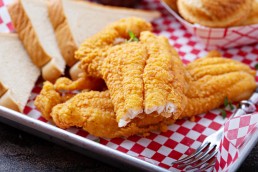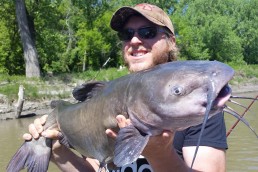A Fresh Taste for Fried Catfish and Drum
SHARE THIS POST
When preparing almost any freshwater fish for frying, most cookbooks will say the best way is to use a half and half mixture of cornmeal and flour with a little salt and pepper. This is fine, but why not add a little zest to your summer fish fry?
Now, I recommend when cooking catfish or drum that you only use the meaty sides of the fish. It has long been touted in culinary articles that the only way to present the delicate meat of a catfish is to cook and serve it whole. Unless you deep fat fry catfish, the boney rib cage doesn’t get done, while the rest of the fish is cooked dry. You just can’t cook the front half of the catfish in an inch of oil. Those ribs have so little meat, why work with them?
For a great catfish fry, skin and gut the fish, cut the rib cage away and fry only the meaty body portion, including fins and tail. With smaller catfish, I keep the body in one piece. Cut larger cats into 3- to 4-inch lengths. Catfish meat is so tender, it must be fried with the bones left down the middle.
For drum, scale only the meaty sides, cutting away the ribs and belly meat. Fillet the meat from the center body bones. For larger drum, cut away any dark lateral line. Leave the tails and fins in place if you like the crunch.
I like to soak drum fillets for five minutes in slightly seasoned water. (I add 1/4 cup of lemon juice and 1 tablespoon of salt to a gallon of water.) Drain the fillets in a colander or on racks for a couple of minutes or dry them on paper towels and put into a plastic bag or bowl with a generous amount of flour. Make sure flour covers the entire fillet. You can refrigerate the flour-covered fillets for a couple of hours. Just check the bag and make sure there is enough flour, so they look dry, not pasty.
At fry time, dip the individual fillets in the liquid of your choice. I personally like mayonnaise or Boetje’s mustard thinned with lemon or lime juice, or I sometimes use a creamy salad dressing, such as ranch, thousand island, blue cheese or garlic. You can also use Italian dressing straight from the bottle. Other options include an egg wash, evaporated milk, and thinned catsup—almost any liquid with a little flavor will work. Adjust other seasonings if you use a commercial salad dressing.
Thousand island dressing is particularly good with larger pieces that have to cook longer. Most blue cheese dressings with chunks work best with quickly cooked smaller pieces. Add salt, pepper, garlic powder or other spices to the wash to taste.
Are you enjoying this post?
You can be among the first to get the latest info on where to go, what to use and how to use it!
Look through the cupboard for other alternatives to typical breading. Crushed, flavored or plain potato chips, cheese crackers or cheese balls over a mayo wash work well. Mashed potato flakes mixed with or without grated Parmesan cheese goes well with a ranch or garlic wash. Grated Parmesan cheese, panko breadcrumbs and garlic powder complement an Italian dressing wash. Flour and cornmeal jazzed up with dry ranch mix, any salad dressing wash, or thinned catsup will add a crunchy new taste.
I usually serve at least two variations, since some in my family want everything spicy while others don’t. For heat, I like pepper and ginger with a dash of Sriracha sauce added to the wash. I also like horseradish and wasabi, but lots of fish eaters think these give the fillets a harsh or bitter taste, so I set out bowls of creamy horseradish, wasabi and pickled ginger on the table next to the tartar sauce and catsup.
Don’t be afraid to doctor the tartar sauce, too. Use any of the thicker creamy salad dressings in place of mayo as the base. Add pickle relish—sweet or dill. I like to use dried onion bits and chopped pimento-stuffed olives, especially with the dill relish.
It is almost impossible to make a bad breading mix or wash. However, the bottom line to successful fried fish depends on two things. First, allow the breaded fillets to rest in the refrigerator, for 10 to 15 minutes or more. Second, heat the oil or shortening to 325 to 350 degrees before adding fillets.
For pan-frying, nothing compares with my grandmother’s large, deep, cast-iron skillet. A decent sized pancake turner, a stabilizing fork and baking racks over cookie sheets to hold the fried fillets complete the setup. I have a second, deep cast iron roasting pot for cornbread. I just melt a few tablespoons of butter in the bottom and fill it with two boxes of cornbread mix. Serve that and some coleslaw with fried fish for a meal straight from the best of the Midwest.
Why settle for the same old fried fish? Use your imagination to add new flare to an old recipe.
MWO
SHARE THIS POST
Did you enjoy this post?
You can be among the first to get the latest info on where to go, what to use and how to use it!
Bess Pierce
Before Dick and Bess Pierce married, they fished. When he was laid off, they set 1000-hook jump lines, daily, to pay bills. They’ve fished rivers and the Great Lakes with children and grandchildren. From a lifetime of experiences, Bess Pierce writes basic how-tos, where-tos and the joy of the Midwest, with an emphasis on outdoor experiences for families. She may be contacted at gemini2624@aol.com.



